Louis R. Bevier, Trevor B. Persons, and Kyle A. Lima
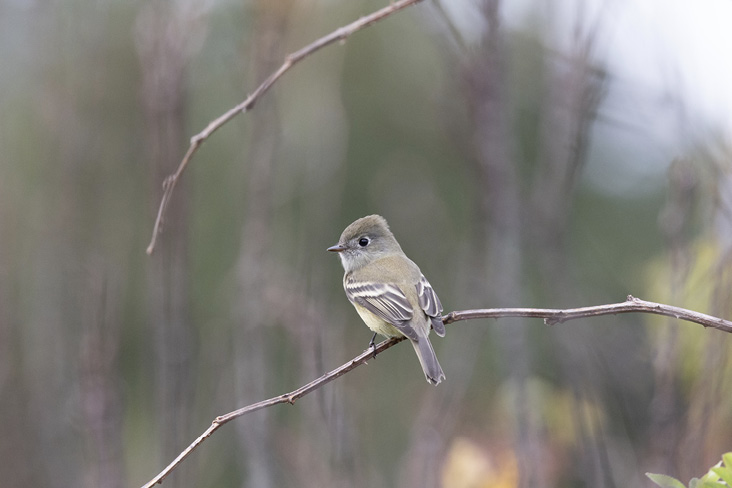
Maine’s first Hammond’s Flycatcher was well-studied on Monhegan Island October 12–18, 2023. Visible in the photograph are key characters that identify this western North American Empidonax flycatcher: proportionately large head and small bill, long projection of primaries beyond the tertials, and a noticeably long gap in spacing between the tips of the fifth and sixth primaries. Photograph by Luke Seitz, October 12, 2023.
The Thirteenth report of the Maine Bird Records Committee—hereafter ME-BRC or the committee—summarizes 67 reports involving 41 species that were evaluated and decided during 2023. The committee accepted 58 records for an acceptance rate of 87%. Although most reports were recent, the years of occurrences ranged from 1978 to 2023.
Two new species were added to the state list: Red-footed Booby (Sula sula) and Hammond’s Flycatcher (Empidonax hammondii). Ring-necked Pheasant (Phasianus colchicus) was transferred from the main list to the list of “failed introduced species” because the few reproducing island populations are periodically augmented by humans. The total number of documented species on Maine’s state list is now 471. The official list of bird species recorded in Maine, our review procedures, and the list of members can be found at the committee’s website: http://sites.google.com/site/mainebirdrecordscommittee.
Records in this report are grouped by species; records accepted and those not accepted are listed within the same species account. Each record provides the location, county (italicized), date(s) of occurrence, names of observers or contributors, and committee record number. Documentation was provided by the observers listed or, in some cases, was obtained from publicly published websites. All reviewed materials and member comments are archived. If known, the names of finders are listed first and separated from other names by a semicolon. Photographic, video, or audio evidence reviewed is denoted by a dagger (†); written notes are denoted by an asterisk (*). As always, the committee strongly encourages written submissions even when there are photographs. Species accounts follow the current taxonomic classification and sequence adopted as of 2023 by the American Ornithological Society (list available at http://checklist.americanornithology.org/taxa/).
Species Accounts
Ross’s Goose (Anser rossii). Single birds were at Bangor, Penobscot, November 15–23, 2022 (Ben Simpson†; Louis Bevier†, Steve Mierzykowski†; 2022-041), Ogunquit, York, December 24–25, 2022 (Richard Garrigus†; Robert Dixon†, Turk Duddy†, David Nelson†; 2022-047), and Limestone, Aroostook, September 17–October 2, 2023 (Wayne Selfridge, Bill Sheehan†; Paul Cyr†, Ashlee Duff†, Shawn Morneault†, Christine Van Wassenhove; 2023-047), bringing the state’s accepted total to 11 records.
Pink-footed Goose (Anser brachyrhynchus). One photographed at Trafton Lake and vicinity, Limestone, Aroostook, October 20–November 11, 2022 (Bill Sheehan†; Rick Hartzell†; 2022-039), provided Maine’s seventeenth record, all since 2009.
Barnacle Goose (Branta leucopsis). Although reviewed separately, what was presumably the same individual was found in Portland, Cumberland, March 1, 2023 (Frank Paul; Ethan Whittaker†; 2023-004), North Yarmouth, Cumberland, March 17, 2023 (Rob Speirs†; 2023-006), and Auburn, Androscoggin, March 22, 2023 (Camden Martin, Gary Jarvis†; 2023-007). Aside from an individual that overwintered in 2021–2022, this is Maine’s first spring record.
Black-bellied Whistling-Duck (Dendrocygna autumnalis). Two were at the Sanford Sewerage lagoons, York, July 7–10, 2023 (Robert Dixon†; Ethan Whitaker†; 2023-029), providing Maine’s fifth accepted record, the first being from the same location in 2010 (2010-006).
Trumpeter Swan (Cygnus buccinator). Scarborough Marsh, Cumberland, March 30, 2022 (Brad Woodward, Noah Gibb; Doug Hitchcox†, Glenn Hodgkins†, Ann Thayer†; 2022-004). Presumably a natural vagrant from the burgeoning reintroduced Great Lakes population.
Tundra Swan (Cygnus columbianus). One was at Fryeburg, Oxford, April 7–8, 2023 (Ed Boyle; Sean Hatch†; 2023-008).
Eared Grebe (Podiceps nigricollis). A breeding-plumaged bird was present on North Pond, Smithfield, Somerset, August 10, 2023 (Karin Lessard†, Dan Lessard; Louis Bevier†, Glenn Hodgkins†; 2023-034).
Chuck-will’s-widow (Antrostomus carolinensis). Although not reported in 2022, presumably the same pair from 2018–2021 returned to Orland, Penobscot, May 11–July 28, 2023 (Craig Kesselheim†, Stephen Mullane; Logan Parker*†, Laura Sebastianelli†; 2023-011). NOT ACCEPTED, IDENTIFICATION QUESTIONED: An intriguing report of a large nightjar flushed on Appledore Island, York, May 31, 2022 (2022-014), unfortunately did not eliminate other species. Another report of one flying among a flock of Common Nighthawks (Chordeiles minor) over Farmington, Franklin, September 2, 2023 (2023-039), lacked convincing details.
Rufous Hummingbird (Selasphorus rufus). A Selasphorus hummingbird in Dayton, York, October 22–November 14, 2022, was banded and identified as an adult female Rufous (Kathy and Richard Colton; Tom Foley†, Doug Hitchcox†, Marjorie Watson†, Scott Wiedensaul*†; 2022-040). Adult males were found in Sorrento, Hancock, July 31–August 3, 2022 (Joanne Van Winkle†; 2022-049), and Frankfort, Waldo, April 30–May 1, 2023 (Ronda Curtis†; John Wyatt†; 2023-009).
Yellow Rail (Coturnicops noveboracensis). One bird was detected in a marsh on the Pleasant River, Addison, Washington, July 20, 2020 (Willy Hutcheson; Louis Bevier*†, Jada Fitch†, Doug Hitchcox†; 2020-056). The calls heard and recorded were the typical loud clicking notes ascribed to male advertisement vocalizations.
Black-necked Stilt (Himantopus mexicanus). A bird at Scarborough Marsh, Cumberland, May 23–29, 2023 (Derek Lovitch†; Alex Lamoreaux†, Ethan Whitaker†; 2023-014), was likely the same individual later found on nearby Stratton Island, York, May 31–July 4, 2023 (Silas Hernandez, Benjamin Becker; Reed Robinson†; 2023-025).
Northern Lapwing (Vanellus vanellus). Single lapwings were found in Thomaston, Knox, December 11, 2022 (Jesse Weaver†; 2022-044), and Kennebunk, York, December 31, 2022, to January 2, 2023 (Dave Tucker†; Sean Hatch†, Doug Hitchcox†, Gary Jarvis†; 2022-048). Unprecedented was a flock of five birds at Hodgdon, Aroostook, December 11–16, 2022 (Aaron Beechy; Ashlee Duff†, Bill Sheehan†; 2022-045). At least one bird lingered until December 24. There are now eight accepted records, all since 2012, and an additional unreviewed report for December 1927 involving a specimen (repository unknown) from Square Lake, Aroostook (Brooks 1928, Peters 1929).
European Golden-Plover (Pluvialis apricaria). NOT ACCEPTED, IDENTIFICATION QUESTIONED: Poor-quality photos of a plover at Spurwink Marsh, Scarborough, Cumberland, May 27, 2023 (2023-016), were more likely of a Black-bellied Plover.
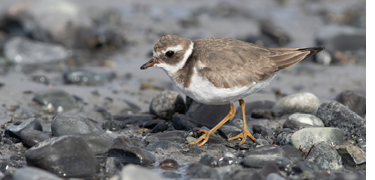
Extremely rare, especially so in winter, was this Common Ringed Plover at Timber Point in Biddeford, January 30 to February 5, 2023. Characters that separate this species from the Semipalmated Plover (Charadrius semipalmatus)— also rare in winter—are the blackish orbital ring, less deep bill, and lack of webbing between the middle and inner toes (see rear foot). Photograph by Doug Hitchcox, January 31, 2023.
Common Ringed Plover (Charadrius hiaticula). One was present at Timber Point, Biddeford, York, January 30–February 5, 2023 (Tom Aversa†; Doug Hitchcox†, Alex Lamoreaux†; 2023-002). In its final days, the bird succumbed to subzero temperatures that extended to the coast. The specimen was retrieved and stored at Maine Audubon’s Gilsland Farm.
Long-tailed Jaeger (Stercorarius longicaudus). An immature was southeast of Eastern Egg Rock, Lincoln, July 11, 2023 (Alex Lamoreaux†; 2023-033). Because this species has been established to occur regularly off the Maine coast in late summer and early fall, it was subsequently removed from the Review List.
Tufted Puffin (Fratercula cirrhata). The Tufted Puffin from 2022 (and probably 2014) returned in summer 2023 (2023-018). It was found on Petit Manan Island, Washington, June 7 and July 31 (Josh Pratt†, Amanda McFarland); Seal Island, Knox, June 7 (explore.org live cam†); Matinicus Rock, Knox, June 8, July 6–8, and July 28 (Keenan Yakola†); and Eastern Egg Rock, Knox, June 29 and July 9–19 (David Mathieu†).
Franklin’s Gull (Leucophaeus pipixcan). Rare in spring, a near-adult was on Stratton Island, York, June 28–July 1, 2023 (Reed Robinson†, Benjamin Becker, Silas Hernandez; 2023-026).
Pacific Loon (Gavia pacifica). Presumably the same molting bird was at Schoodic Point, Hancock, May 9, 2023 (Don Lima, Kyle Lima†; 2023-010), and June 4, 2023 (Kyle Lima, Seth Benz; Mark Brown†; 2023-017). A winter-plumaged bird was well photographed at Lubec, Washington, September 11, 2023 (Elaine Marie†; 2023-042). NOT ACCEPTED, IDENTIFICATION QUESTIONED: Distant photos of two separate birds flying past Schoodic Point, Hancock, September 29, 2023 (2023-045 and 2023-049), were not identifiable to species.
Yellow-billed Loon (Gavia adamsii). NOT ACCEPTED, IDENTIFICATION QUESTIONED: A Common Loon (Gavia immer) with what appeared to be an oddly colored beak somewhat resembling Yellow-billed Loon was photographed on Green Lake, Ellsworth, Hancock, July 17, 2015 (2015-026). The bird’s plumage pattern, especially the size and number of white scapular marks, helped correctly identify the bird. This bird was another in a series of Common Loons reported in Maine and New England where the bill color has appeared pale and even yellowish, either as a result of color change due to shedding of the rhamphotheca or as a result of lighting effects in photographs. These birds highlight an underappreciated identification pitfall.
Yellow-nosed Albatross (Thalassarche chlororhynchos). An adult seen in outer Muscongus Bay, Lincoln, July 8, 2023, was the expected Atlantic subspecies T. c. chlororhynchos (Jeff Cherry, Mael Glon†; 2023-030). This subspecies and the Indian Ocean populations (T. c. carteri) are split into separate species by some authorities.
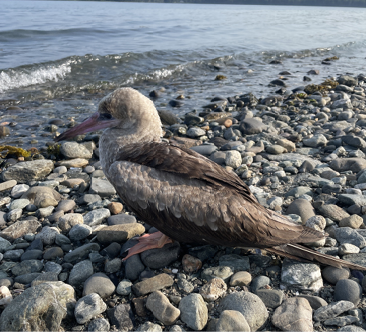
Maine’s first Red-footed Booby was an immature brown morph found by Carter Middleswart. The bird was resting on a rocky beach in Lamoine, June 12, 2023; it flew out to sea shortly after being seen. Photograph by Nicole Middleswart.
Red-footed Booby (Sula sula). Maine’s first Red-footed Booby was an immature brown morph found and photographed resting on the cobbled shoreline at Marlboro Beach, Lamoine, Hancock, June 12, 2023 (Carter Middleswart†; 2023-031). Given the increase in warm-water boobies appearing in New England and the Maritimes, this species’ appearance was not a total surprise. The first Red-footed Booby in this wider region was an immature photographed 750 kilometers east southeast of Portland, Maine, in Nova Scotia waters September 22, 2014 (Abbott and Gjerdrum 2015).
American White Pelican (Pelicanus erythrorhynchos). Although reports from 2014 onward are no longer reviewed and many older records have never been reviewed, the committee did formally review a record of a bird on Flagstaff Lake near Stratton in the town of Eustis, Franklin, June 9–10, 1978 (P. A. Cross; Peter Vickery†; 1978-004). The location was incorrectly published as Stratton Island, York, in Vickery (2020). The Flagstaff Lake bird was the first reported in Maine in more than 30 years, since one at Blue Hill, Hancock, in late August 1945 (Palmer 1949).
White-faced Ibis (Plegadis chihi). Although one committee member thought that a bird in Phippsburg, Sagadahoc, June 1, 2022 (Kate Wong†; 2022-018), could be a hybrid with Glossy Ibis (Plegadis falcinellus), most thought it was a White-faced Ibis, noting that there was no obvious evidence of a first-generation hybrid while admitting that possible subsequent generations of backcrosses could not be eliminated.
Steller’s Sea-Eagle (Haliaeetus pelagicus). The same bird from December 30, 2021, to March 5, 2022 (2021-054), returned to Maine, showing in Georgetown, Sagadahoc, February 4–14, 2023 (Stacy Hildreth; Matt Felperin†; 2023-003).
Mississippi Kite (Ictinia mississippiensis). An adult was photographed in a residential neighborhood in Cape Neddick, York, May 13, 2023 (Miriam Stevens†; 2023-012).
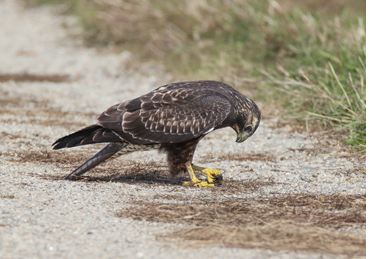
This juvenile dark morph Swainson’s Hawk in Lamoine was enjoyed by many observers from September 24 to October 15, 2023. Photograph by Zachary Holderby, September 26, 2023.
Swainson’s Hawk (Buteo swainsoni). An immature dark morph in Lamoine, Hancock, September 24–October 15, 2023 (Turk Duddy† and Linda Woodard; David Bergstrom†, Tom Foley†, Michael Good†, Zachary Holderby†, Rob Speirs†; 2023-044), is Maine’s fifth accepted record, with 10 reports spanning 1886 to 2005 remaining to review.
Crested Caracara (Caracara plancus). Presumably the same wandering adult was seen in spring 2023 in Cape Elizabeth, Cumberland, May 23 (Lysle Brinker*; 2023-013), with an unconfirmed report from later the same day in Fryeburg, Oxford; Bristol, Lincoln, May 25 (Susan Metzger†; 2023-015); Swanville and Monroe, Waldo, June 5–6 (Pat Dwyer†, John Wyatt†; Kyle Lima†; 2023-019); and Union, Knox, June 9–10 (Eddy Edwards, Kate Doiron; Michelle Hodgdon†, Ethan Whitaker†; 2023-022). Possibly the same bird was seen in Pennsylvania in April and on Prince Edward Island, Canada, in July.
Acadian Flycatcher (Empidonax virescens). Eight records were accepted: Cape Elizabeth, Cumberland, June 7, 2008 (Eric Hynes*; 2008-017); Appledore Island, York, May 29, 2010 (Luke Seitz†; 2010-023); Fort Foster, Kittery, York, May 21, 2013 (Derek and Jeannette Lovitch†; Doug Hitchcox†; 2013-028); Monhegan Island, Lincoln, May 26–31, 2013 (Doug Hitchcox†; Joanne Normandin†, Luke Seitz†; 2013-029); Durham, Androscoggin, June 2–5, 2022 (Robby Lambert†, Derek Lovitch†; Ian Carlson; 2022-016); Monhegan Island, Lincoln, May 19, 2022 (Luke Seitz, Jeremiah Trimble†, Maili Waters; 2022-050); Hinckley Park, South Portland, Cumberland, June 6, 2023 (Chris Brown, Alex Lamoreaux†; Janis McLaren†; 2023-020); and Laudholm Farm, Wells, York, June 12–14, 2023 (Dan Gardoqui; David Nelson†; 2023-021).
Hammond’s Flycatcher (Empidonax hammondii). Maine’s first was found on Monhegan Island, Lincoln, October 12–18, 2023 (Luke Seitz†, Jeremiah Trimble†, Maili Waters; Doug Hitchcox†; 2023-050).
Say’s Phoebe (Sayornis saya). One was present for only a day at East Point, Biddeford Pool, York, October 8, 2022 (Chandra Goetsch†; 2022-034).
Cassin’s Vireo (Vireo cassinii). NOT ACCEPTED, IDENTIFICATION QUESTIONED: A bird photographed at Sears Island, Searsport, Waldo, September 15, 2023 (2023-043), was thought to be a dull Blue-headed Vireo (V. solitarius) based on the pattern of white on the outermost tail feathers that showed a broad fringe of white and a subtle but clear notch to the dark part of the outer web near the tip of the feather. For illustration of this pattern, see Buckley and Mitra (2003). Other aspects of the bird’s plumage also suggested Blue-headed Vireo over Cassin’s, a species pair that is extremely difficult to separate. Photographs showing the ventral side of the tail, including the outer rectrix, and the entire bird in good lighting are necessary to allow identification of this species pair.
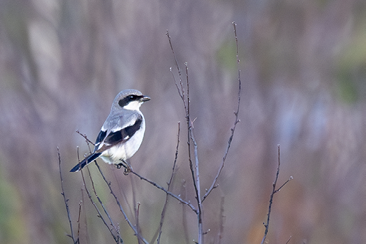
The first Loggerhead Shrike to visit Maine since 2009 was found by a Brookline Bird Club group at Kennebunk Plains June 25, 2023, and was seen only that day. Photograph by Dan Gardoqui.
Loggerhead Shrike (Lanius ludovicianus). Maine’s first Loggerhead Shrike since 2009 was a one-day wonder found during a Brookline Bird Club field trip to Kennebunk Plains, York, June 25, 2023 (Brookline Bird Club; Dan Gardoqui†, Magill Weber†; 2023-023).
Black-billed Magpie (Pica hudsonia). NOT ACCEPTED, ORIGIN QUESTIONED: An apparent magpie photographed in a residential yard in Port Clyde, Knox, June 21, 2023 (2023-024), was possibly an escaped captive. Photos were not clear enough to determine whether the bird was indeed a magpie, let alone which species of magpie it was. The report was submitted as Black-billed Magpie, but other species of black-billed magpies are possible, for example Eurasian Magpie (Pica pica), which has been recorded as an escapee in North America. Two older reports of this species in Maine during 1973 and 1991 remain unreviewed.
Sedge Wren (Cistothorus stellaris). One was at Big Nash Island, Addison, Washington, October 17, 2022 (Evan Obercian*, Evan Strusinki†; 2022-036).
Sage Thrasher (Oreoscoptes montanus). Maine’s second record was of one present at Gilsland Farm, Falmouth, Cumberland, December 22, 2022, to January 11, 2023 (Sue Malcolm, Doug Hitchcox†; Charles Duncan†, John Lorenc†, Rob Speirs†, Ethan Whitaker†; 2022-046). The previous record was at Cape Neddick, York, in the fall of 2001 (2001-004).
Harris’s Sparrow (Zonotrichia querula). One visited a feeder at Turner, Androscoggin, January 8–May 3, 2023 (Anne Brown†; Louis Bevier†, Doug Hitchcox†, Gary Jarvis†, Becky Marvil†, Marjorie Watson†; 2023-001).
LeConte’s Sparrow (Ammospiza leconteii). A bird molted from juvenal to basic plumage during its stay in Stratton (Eustis), Franklin, September 5–28, 2023 (Jeanne Tucker*†; 2023-040), much like one in Unity, Waldo, September 14–28, 2021 (2021-040; Persons et al. 2022). The early arrival date of these birds suggests they may originate from southern Quebec, or even perhaps from an undiscovered Maine breeding population.
Bullock’s Oriole (Icterus bullockii). An immature male visiting a feeder in Westbrook, Cumberland, mid-December 2022 to March 5, 2023, was enjoyed by many birders thanks to kind accommodation of the homeowner (Dianne White†; Laura Blutstein†, Charles Duncan†; 2022-051).
Western Meadowlark (Sturnella neglecta). One visited Mount Desert Rock, Hancock, June 11, 2023 (Levi Sheridan†; 2023-038). This record is the second accepted for Maine, with several older reports spanning the years from 1960 to 2002 not yet reviewed.
Kentucky Warbler (Geothlypis formosa). A male was at Fort Foster, Kittery, York, May 15–16, 2022 (Robert Dixon†; Ethan Whitaker†; 2022-043). NOT ACCEPTED, IDENTIFICATION QUESTIONED: A bird at Falmouth, Cumberland, May 17, 2022 (2022-052), was likely a Kentucky Warbler, but the report lacked documentation and the brief description did not conclusively eliminate other species.
Kirtland’s Warbler (Setophaga kirtlandii). Maine’s second was a hatch-year bird on Matinicus Rock, Knox, September 10, 2023 (Keenan Yakola*†; 2023-041). Maine’s first was a spring record in 2008 at Kennebunk Plains, Kennebunk, York (2008-003).
Corrigendum
Maine’s first Mountain Bluebird (Sialia currucoides) (2011-012), on East Royce Mountain, was published as November 13, 2011 (Persons et al. 2015), but November 12, 2011, is the correct date based on new information from the observer confirming the timestamp date in photos.
Acknowledgments
As ever, the committee acknowledges with thanks and deep appreciation the submissions of documentary evidence provided by the observers cited above. Lindsay Webb helped correct the Mountain Bluebird date noted above. We wish to thank our fellow committee members for comments on the draft and our secretary, Becky Marvil, without whom these reports would not be possible.
References
- Abbott, S. and C. Gjerdrum. 2015. Red-footed Booby (Sula sula): New to Nova Scotia and Canada. North American Birds 68 (2):174–177.
- Brooks, W. S. 1928. Museum Notes: Birds. Bulletin of the Boston Society of Natural History 49:17.
- Buckley, P. A. and S. S. Mitra. 2003. Williamson’s Sapsucker, Cordilleran Flycatcher, and other long-distance vagrants at a Long Island, New York stopover site. North American Birds 57 (3):292–304.
- Palmer, R. S. 1949. Maine Birds. Bulletin of the Museum of Comparative Zoology at Harvard College, vol. 102.
- Persons, T. B., T. Aversa, K. A. Lima, M. Weber, and L. R. Bevier. 2022. Eleventh Report of the Maine Bird Records Committee. Bird Observer 50 (2):87–96, 108–109.
- Persons, T. B., L. R. Bevier, P. D. Vickery, W. J. Sheehan, and C. A. Bartlett. 2015. Fourth report of the Maine Bird Records Committee. Bird Observer 43 (1):21–37.
- Peters, J. L. 1929. The European Lapwing. Bulletin of the Boston Society of Natural History 51:10–12.
- Vickery, P. D. 2020. American White Pelican. In Birds of Maine. P. D. Vickery, C. D. Duncan, J. V. Wells, and W. J. Sheehan. Memoirs of the Nuttall Ornithological Club, No. 25. Princeton, New Jersey: Princeton University Press. p. 305.
